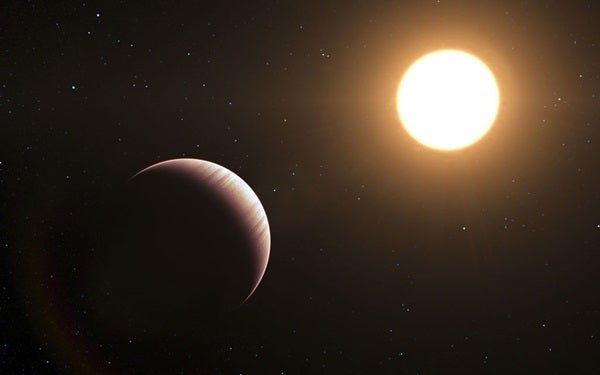Tau Boötis b was one of the first exoplanets to be discovered back in 1996, and it is still one of the closest exoplanets known. Although its parent star is easily visible with the naked eye, the planet itself certainly is not, and up to now, it could only be detected by its gravitational effects on the star. Tau Boötis b is a large “hot Jupiter” planet orbiting close to its parent star.
Like most exoplanets, this planet does not transit the disk of its star (like the recent transit of Venus). Up to now, such transits were essential to allow the study of hot Jupiter atmospheres — when a planet passes in front of its star, it imprints the properties of the atmosphere onto the starlight. As no starlight shines through Tau Boötis b’s atmosphere toward us, this means the planet’s atmosphere could not be studied before.
But now, after 15 years of attempting to study the faint glow that is emitted from hot Jupiter exoplanets, astronomers have finally succeeded in reliably probing the structure of the atmosphere of Tau Boötis b and deducing its mass accurately for the first time. The team used the CRIRES instrument on the VLT at ESO’s Paranal Observatory in Chile. They combined high-quality infrared observations — at wavelengths around 2.3 microns — with a clever new trick to tease out the weak signal of the planet from the much stronger one from the parent star.
“Thanks to the high-quality observations provided by the VLT and CRIRES, we were able to study the spectrum of the system in much more detail than has been possible before,” said Matteo Brogi from the Leiden Observatory in the Netherlands. “Only about 0.01 percent of the light we see comes from the planet, and the rest from the star, so this was not easy.”
The majority of planets around other stars were discovered by their gravitational effects on their parent stars, which limits the information that can be gleaned about their mass — they only allow a lower limit to be calculated for a planet’s mass. The new technique pioneered here is much more powerful. Seeing the planet’s light directly has allowed the astronomers to measure the angle of the planet’s orbit and work out its mass precisely. By tracing the changes in the planet’s motion as it orbits its star, the scientists have determined reliably for the first time that Tau Boötis b orbits its host star at an angle of 44° and has a mass six times that of Jupiter.
“The new VLT observations solve the 15-year-old problem of the mass of Tau Boötis b,” said Ignas Snellen from the Leiden Observatory in the Netherlands. “And the new technique also means that we can now study the atmospheres of exoplanets that don’t transit their stars, as well as measuring their masses accurately, which was impossible before. This is a big step forward.”
Besides detecting the glow of the atmosphere and measuring Tau Boötis b’s mass, the scientists have probed its atmosphere and measured the amount of carbon monoxide present, as well as the temperature at different altitudes by means of a comparison between the observations and theoretical models. A surprising result from this work was that the new observations indicated an atmosphere with a temperature that falls higher up. This result is the exact opposite of the temperature inversion — an increase in temperature with height — found for other hot Jupiter exoplanets.
The VLT observations show that high-resolution spectroscopy from ground-based telescopes is a valuable tool for a detailed analysis of non-transiting exoplanets’ atmospheres. The detection of different molecules in the future will allow astronomers to learn more about the planet’s atmospheric conditions. By making measurements along the planet’s orbit, astronomers may even be able to track atmospheric changes between the planet’s morning and evening.
“This study shows the enormous potential of current and future ground-based telescopes, such as the E-ELT,” said Snellen. “Maybe one day we may even find evidence for biological activity on Earth-like planets in this way.”










